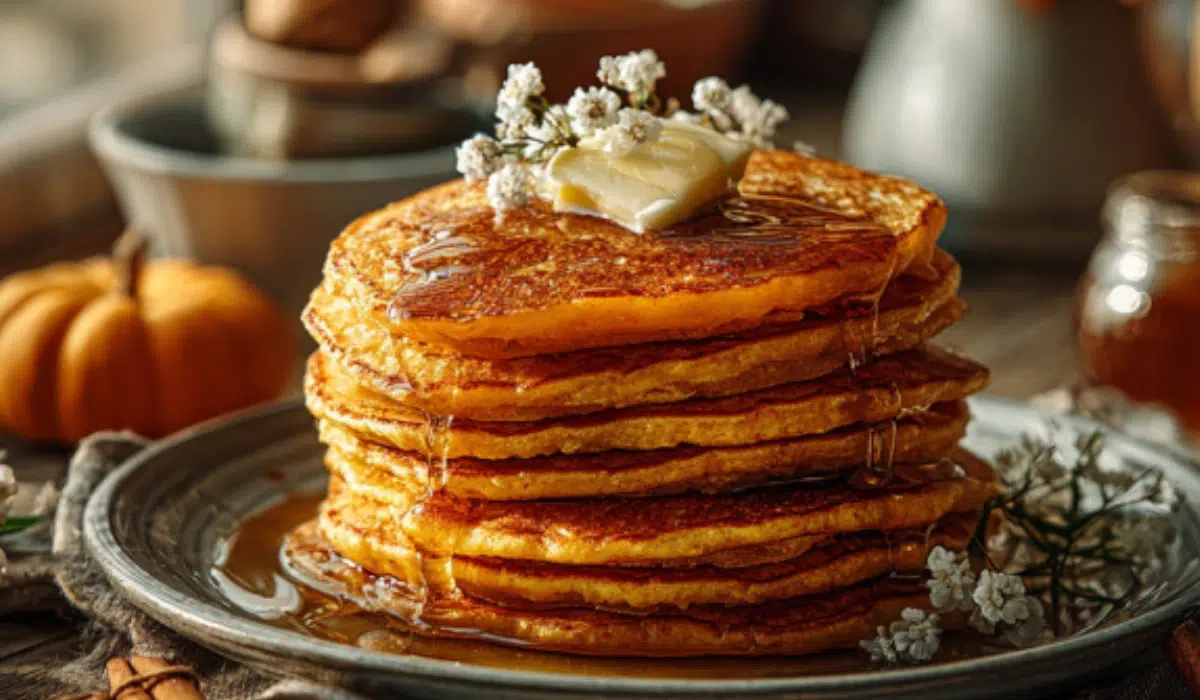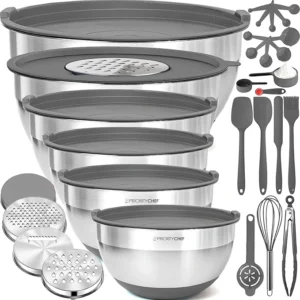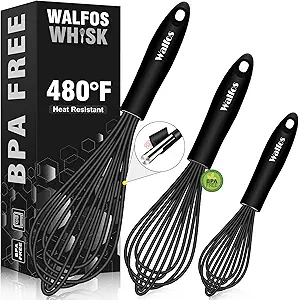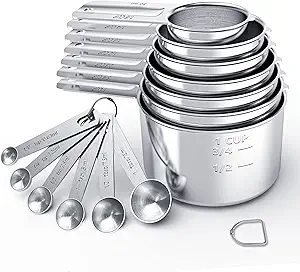Pumpkin pancakes bring cozy autumn flavors to your breakfast table in the most comforting way. These fluffy, golden rounds carry the warm spice of cinnamon, ginger, and allspice blended with smooth pumpkin puree. Unlike plain pancakes, this version adds richness and depth, giving every bite a soft, cake-like texture that feels special yet effortless. Whether you are planning a slow weekend brunch or looking for a seasonal treat, this recipe delivers reliable results and a stack that tastes like fall on a plate.
Table of Contents
Why You’ll Love Pumpkin Pancakes
- Quick and reliable: The batter comes together in minutes, perfect for busy mornings.
- Simple ingredients: Everything you need is likely already in your pantry.
- Fluffy and flavorful: Pumpkin puree adds moisture while warm spices create that cozy autumn taste.
- Crowd-pleasing: Kids and adults love these pancakes, making them a safe bet for family breakfasts.
- Freezer-friendly: Make a big batch, freeze extras, and reheat for a homemade treat anytime.
These pumpkin pancakes stand out because they balance sweetness and spice without being heavy. The texture is soft yet hearty, and the flavor is warm but not overpowering, giving you a perfect bite every time.
Ingredients Needed
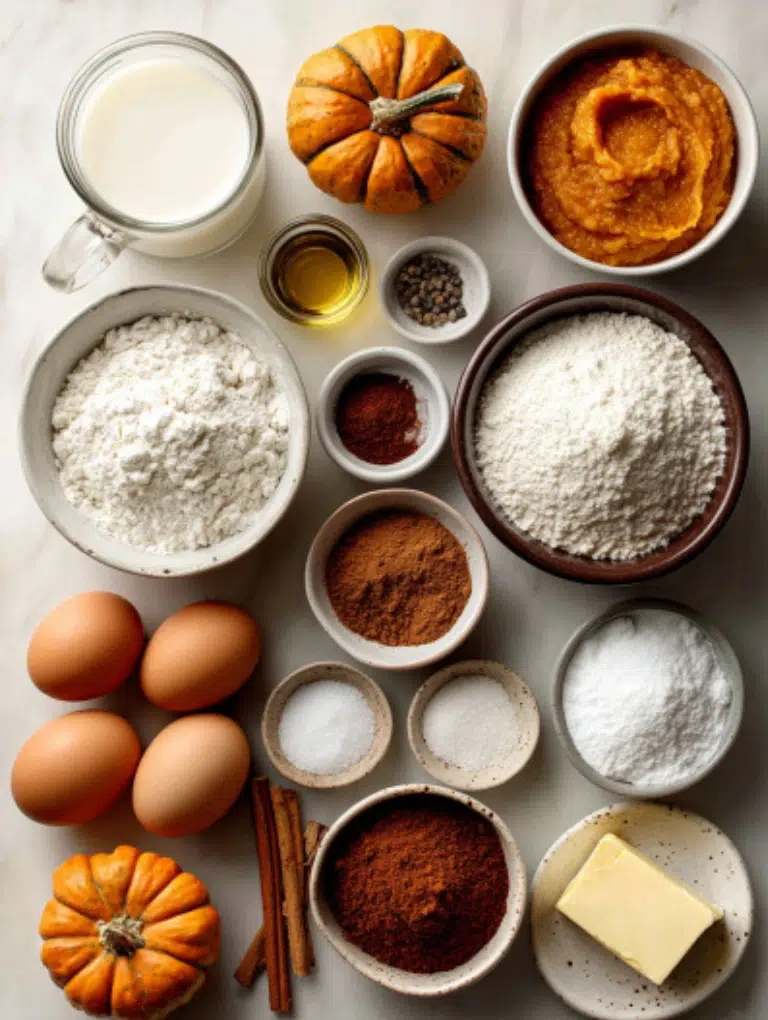
Dry Ingredients
- All-purpose flour: the base that gives structure.
- Brown sugar: adds sweetness with a hint of molasses depth.
- Baking powder and baking soda: the leavening duo that makes pancakes fluffy.
- Ground spices: cinnamon, allspice, and ginger provide warm fall flavor.
- Salt: sharpens and balances the sweetness.
Wet Ingredients
- Milk: whole milk or your preferred alternative keeps the batter smooth.
- Pumpkin puree: canned works best for consistency, but homemade is fine if thick.
- Egg: binds everything together and helps lift the pancakes.
- Vegetable oil: keeps them moist and tender.
- Vinegar: reacts with the baking soda for extra fluff.
Optional Add-ins & Toppings
- Chocolate chips, pecans, or walnuts folded into the batter.
- Maple syrup, nutmeg whipped cream, or a dusting of powdered sugar for serving.
Notes & Substitutions
- Gluten-free: Replace the flour with a 1-to-1 gluten-free baking blend.
- Dairy-free: Swap in almond or oat milk and use neutral oil instead of butter.
- Egg-free: Try a flaxseed “egg” (1 tablespoon ground flax + 3 tablespoons water).
- Flavor tweak: Add nutmeg or cloves for a bolder spice mix.
How to Make Pumpkin Pancakes
1. Before You Start
Lightly coat a griddle or skillet with cooking spray or oil. Set it over medium-high heat so it’s hot by the time your batter is ready. Preheating ensures even browning.
2. Mix the Wet Ingredients
In a large bowl, whisk together the milk, pumpkin puree, egg, vegetable oil, and vinegar until smooth and well combined. The vinegar kick-starts leavening.
3. Mix the Dry Ingredients
In a separate bowl, combine flour, brown sugar, baking powder, baking soda, cinnamon, allspice, ginger, and salt. Stir until the spices are evenly distributed.
4. Combine Without Overmixing
Pour the dry mixture into the wet ingredients. Gently stir until just blended. A few streaks of flour are fine overmixing can make pancakes tough.
5. Portion the Batter
Scoop about 3 to 4 tablespoons of batter for each pancake onto the hot griddle. Spread slightly with the back of a spoon to form even rounds.
6. Cook the First Side
Cook until bubbles appear on the surface and the edges start to set, about 2 minutes. This is your cue that the bottom is golden.
7. Flip and Finish
Flip carefully and cook the second side until golden brown, about 2 more minutes. Transfer to a plate and cover loosely to keep warm.
8. Repeat and Serve
Continue with the remaining batter, adjusting heat if needed. Serve hot with your favorite toppings.
Pro Tips & Troubleshooting
Expert Tips
- Use room-temperature ingredients: Cold milk or eggs can prevent the batter from mixing evenly.
- Don’t rush the flip: Wait for bubbles across the surface before turning to keep them fluffy.
- Rest the batter: Let it sit for 5 minutes before cooking so the flour hydrates and the pancakes rise higher.
- Medium heat is key since cooking pancakes too hot can leave them burnt outside and raw inside.
Common Mistakes to Avoid
- Overmixing the batter: This creates dense, chewy pancakes. Stir only until combined.
- Using watery pumpkin puree: If homemade puree is thin, blot with paper towels to remove excess moisture.
- Skipping vinegar or acid: That little bit of acidity makes pancakes extra tender.
Creative Trick
For evenly golden pancakes, wipe the skillet lightly with oil between batches it prevents sticking and gives each round a fresh start.
Serving, Storage & Variations
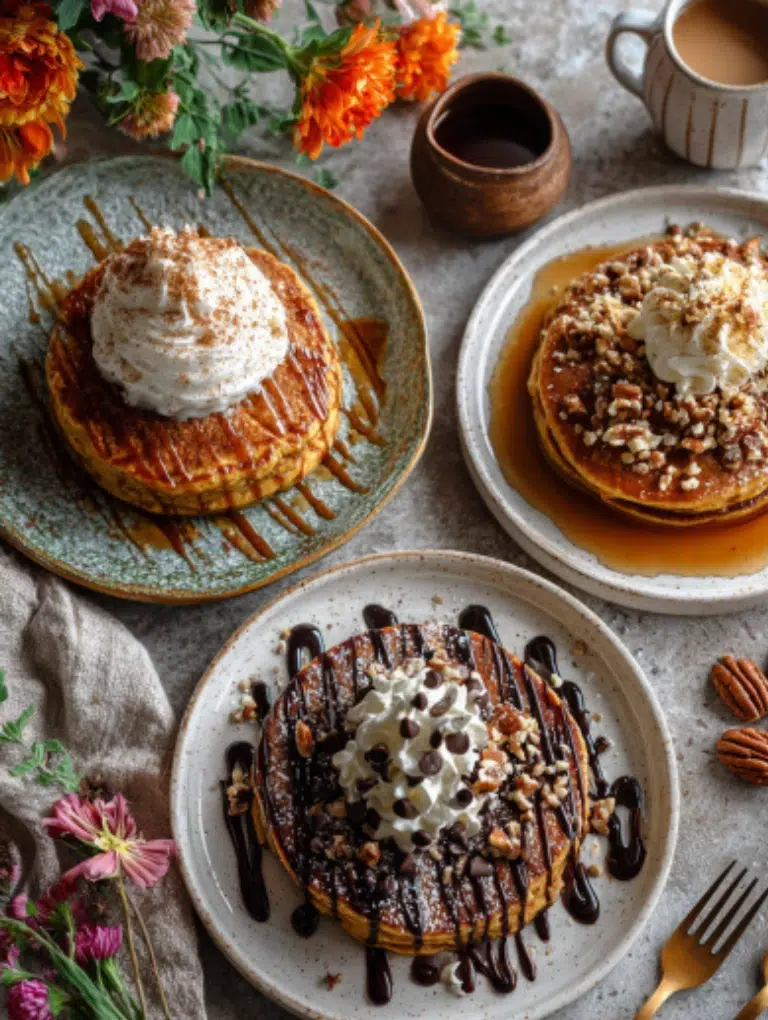
Serving Ideas
- Classic maple syrup and a pat of butter.
- A dollop of nutmeg whipped cream with a sprinkle of cinnamon.
- Toasted pecans or walnuts for crunch.
- Chocolate chips or a drizzle of caramel sauce for dessert-style pancakes.
Storage
- Refrigerator: Store leftovers in an airtight container for up to 3 days.
- Freezer: Place cooled pancakes in a single layer on a baking sheet, freeze, then transfer to a freezer bag. They’ll keep for 2 months.
Reheating
- Microwave: Quick and easy, though a bit softer in texture.
- Oven or toaster oven: 300°F for 8–10 minutes restores fluffiness.
- Toaster: Best for single servings, gives crisp edges.
Variations
- Gluten-free: Swap in a 1-to-1 gluten-free flour mix.
- Dairy-free: Use oat or almond milk and skip butter.
- Protein boost: Add a scoop of vanilla protein powder or top with Greek yogurt.
- Kid-friendly minis: Make smaller silver-dollar pancakes for little hands.
Nutritional Information
Below is the approximate nutrition per serving (based on 6 servings):
| Nutrient | Amount |
|---|---|
| Calories | 268 |
| Protein | 8 g |
| Fat | 6 g |
| Carbohydrates | 45 g |
| Fiber | 3 g |
| Sodium | 592 mg |
| Calcium | 200 mg |
| Iron | 3 mg |
Benefits Breakdown
- Pumpkin puree contributes fiber, vitamin A, and natural sweetness, as listed in USDA FoodData Central nutrition data.
- Spices such as cinnamon and ginger provide antioxidant properties, as reported in research published by the National Library of Medicine.
- Eggs and milk supply protein for staying power.
- Brown sugar gives quick energy but balances with pumpkin’s nutrients.
Tip: If you modify ingredients, like using almond milk or gluten-free flour, use a nutrition calculator such as Cronometer or MyFitnessPal to confirm values.
Conclusion
Pumpkin pancakes are the kind of breakfast that makes an ordinary morning feel special. Soft, fluffy, and warmly spiced, they bring comfort and seasonal flavor to every bite. This recipe is easy enough for weekdays yet impressive enough for a cozy brunch spread. With simple pantry staples and a few pro tips, you can enjoy a stack that turns out perfect every time.
If you try these pancakes, leave a comment and a star rating I’d love to hear how they turned out for you. Share your creations on Pinterest or Facebook so others can enjoy them too. What toppings did you try? Let us know in the comments below!
Frequently Asked Questions
Which pumpkin puree works best for pancakes?
Canned pumpkin puree works best because it has a consistent thickness. If using homemade puree, make sure it’s well-drained and not watery.
Can I make these without buttermilk?
Yes. Mix 1 cup milk with 1 tablespoon vinegar or lemon juice, let sit for 5 minutes, and use in place of buttermilk.
How do I make gluten free pumpkin pancakes?
Swap the all-purpose flour for a 1-to-1 gluten free baking mix. For best results, let the batter rest a few extra minutes before cooking.
What are the best dairy free swaps?
Use almond or oat milk in place of regular milk and a neutral oil instead of butter. Coconut cream also works as a topping.
Why do my pumpkin pancakes turn dense or gummy?
This usually happens from overmixing or using thin pumpkin puree. Stir gently and use a thick, canned puree for fluffier results.
Can I freeze pumpkin pancakes and for how long?
Yes. Freeze cooled pancakes in a single layer, then store in a freezer bag for up to 2 months. Reheat in the toaster or oven.
How do I keep pancakes warm and fluffy for a crowd?
Place cooked pancakes on a baking sheet in a 200°F oven. This keeps them warm without drying them out until ready to serve.

